709-218-7927 The Landfall Garden House 60 Canon Bayley Road CANADA A0C 1B0 |
|---|
Vermicomposting in the cold-climate apartment - Reports
Next!
All three vermicomposter models offer the same, or a reduced footprint.
All three models offer a reduced food-surface area.
- More uniform digestion
- Focussed
- Moderated worm population.
Update
SM>So Chris, how does your worm composting grow? I recall that you began a
SM>I'm not sure it is something I could maintain for long periods.
It goes almost well. I have an infestation of fungus-gnat, which will drive me crazy soon. I'm hanging in for the warm weather so that I can re-site on the balcony and let the soil dry out a bit.
You will recall that I had a couple of towers, one using a 4" sewer pipe bolted vertically to a rectangular bin, one a series of 25-litre pails stacked one atop the other.
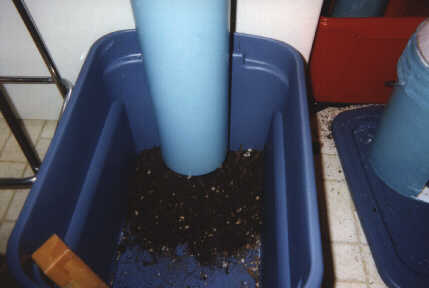
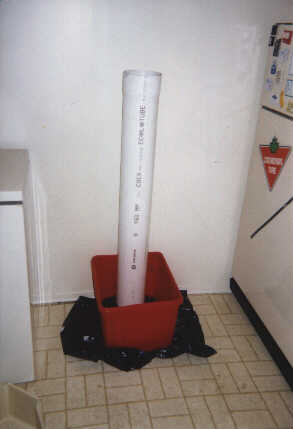
I have abandoned the 4" pipe as being too narrow. The damp soil stuck to the sides of the pipe and had enough particle grip to hold a pillar of soil. I had to use a "pusher" to free the soil.
Messy.
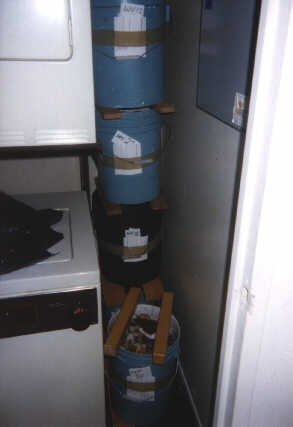
I have trimmed the installation down to two pails only (at one stage I was using four) and two seem to suffice for my household. There are two of us eating and chucking out scraps, one of us cooking and experimenting. The two-pail kit devours all my bio-waste, including coffee grounds, peels, chicken bones etc (which have the flesh cleaned right off them). When I'm bored I tear up a cardboard mailer and feed that to my footless flexible friends.
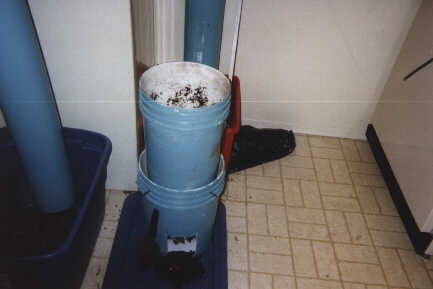
About once every two days I tip the bit-tub (1 KG margarine container with drain holes punched in the bottom) onto the top of the composter, I garden-trowel into a laundry detergent bottle (with the base trimmed off to make a scoop-shovel) about two litres of soil from the 4" square doorway at the base, and this bottom-fall soil goes onto the top to cover the food scraps.
About once or twice a day I rotate the upper pail on the lower.
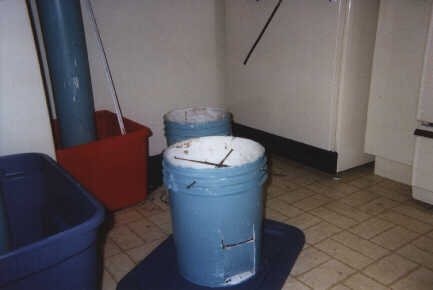
Since the lower has a couple of 1/4" steel rods across the top, these not only support the top pail, but during rotation help to shear off and distribute the soil falling from the upper to the lower pails.
This method of top-loading, bottom-extracting means that the red-wriggler population stays in the top pail, well out of sight, since they seem to gravitate (!) upwards to where the fresh food is. When I see wrigglers tumbling out the bottom, it's a red-wriggler day.
In the soil I scoop from the base, I ALWAYS have hundreds of 5 mm white worms. When those suckers aren't eating, they're doing sumpn' else!
Apropos eating. The proof, as they say, is in the pudding. With a tower only two feet high, I very rarely see undigested food scraps coming out the bottom. That tells me that the worm population is alive and well and is doing its job. I rarely see a worm, but they are hard at it. I suspect that the presence of food scraps at the base (and hence the presence of red-wrigglers) is on account of too-speedy a descent of material from the top to the bottom. That probably means that a large hole gaped in the soil stack, and top material caved in too quickly. Rotating the upper pail three times a day might cure this.
Overall, I'm very, very pleased with my experiment, the fungus gnats notwithflying (reason for those appears below). I've maintained a Vermicomposting setup for nearly two years now, through two Toronto winters, with a minimum of fuss. During all that time I've tossed only ONE plastic bag of food-scraps down the garbage chute (did a big batch of cooking with sugar for a church function) and have obtained much compost for house plants.
Fungus Gnats
These are the little fruit-fly like things. I believe they infest houseplants when the soil is too damp. In my case, when I brought the composter in from the balcony last fall, I placed a piece of cardboard to act as a door across the 4' doorway, to prevent the soil spilling out while I reloaded. I left the door in place too long, probably shouldn't have used it at all. I loaded soil and periodic scraps until the composter was full, and only then removed the door. I think the door inhibited air circulation, and allowed a build-up of moisture. Without the door the worms would probably have eaten and stirred enough to keep the soil in a dryer state.
Gravitation: hasn't worked as well as I'd hoped. I'd thought that the worms would, in moving throughout the mass, cause the soil quickly to settle to the bottom. The worms go to the top, where the food is, so there is very little movement at the bottom.
Nonetheless I garden-trowel out soil from the base, and the pillar of soil appears to settle and drop down over about a twelve-hour period.
I am confident that the composter holds enough food and moisture to sustain the worm population over a three-week absence on vacation or business.
Update Saturday, October 06, 2001
A smaller footprint!
I collected two plastic pails from a Coffee Time donut shop. The pails are square in section, 10” across the top, 8” across the base. The plastic can be cut with a kitchen knife. I took a 4” square door out of the lower pail, and cut the base from the upper pail. Two ¼” steel rods are placed in parallel 7” apart across the lower bin. For the tray I grabbed the vegetable tray from an old refrigerator. The tray measures 20” by 14” and is of a sturdy waterproof plastic.
Saturday, June 21, 2003
Relax. I’ve not been idle for 18 months – I’ve been very busy.
This morning I harvested a carton marked “eating”. About once per month I separate worms, eggs and castings.
My “eating” bin is a cardboard carton, about 20 inches long, 10 inches high and 10 inches wide. The regular sort of carton obtained from a grocery store. The carton is lined with a black plastic garbage bag
Six weeks ago, after a previous separation, I’d tipped a mixture of worms, undigested paper and food scraps into the bin, draped the loose ends of the plastic over the top (allowing some air movement) and left it sitting on the floor in an undisturbed corner.
So, this morning, I spread a large plastic garbage bag on the table, and sieved the contents of my eating bin onto the table.
The sieve is a black plastic seedling tray, rescued from the dumpster behind the garden centre. The tray is about 20 inches long, 9 inches wide, and about 1.5 inches deep. The base and sides are preforated with holes about half an inch across.
I use a small blue plastic trowel (think “children’s sand pit”) to shovel mixture into the sive, and agitate the sieve gently. Castings and some worms drop through, and I’m left with paper garbage and worms in the sieve. I shake only a little, because I don’t want to guilottine worms which are passing through the sieve!.
The material left in the sieve needs further digestion, so I tip that into a spare bin (refrigerator drawer), and repeat the process. By the end, I have a bin of undigested scraps and a heap of castings, worms and eggs on the table.
I now make use of a plastic tub, in which was once one pound of soya margarine, and a white plastic tea-spoon, obtained at great expense by purchasing and consuming yet another sundae. I carefully scrape a teaspoon of castings towards me to an empty place on the cloth, and transfer exposed worms and eggs to the margarine tub. The tub gradually fills with worms, eggs and small amounts of castings, and the pile of castings in front of me grows. The pile of sieved material shrinks, and reduces to a writhing mass of worms.
Back to the tower vermicomposter: I take this weeks kitchen scraps bucket and empty it into the vermicomposter, on top of the shredded paper I’d placed there last week. The refrigerator bin of undigested scarps with worms goes next, and finally the margarine tub with rescued worms and eggs on top of that, and the vermicomposter is left to digest for another week.
The pile of castings is troweled into palstic milk bags, and today I harvested five one-litre plastic bags of castings. I sit them in a small carton in a dark corner. I can give them away as is, or I can wait another month and harvest any hatched worms from eggs I missed today.
Friday, June 27, 2003
So what do you do when you discover that bone scraps (from that plate of ribs) managed to get fly-blown before being placed in the lidded kitchen scraps pail? It all depends on how squeamish you are. I gag and retch at the sight of maggots, and tossing the lot down the garbage chute isn’t an option for me. I have no outdoors in which to bury the crawling mess.
I started into vermicomposting with “Vermicomposting in the cold-climate apartment”, and “cold” is the operative word here.
I grab a large thick plastic bag, the sort obtained from a department store, and with it a regular supermarket bag.
I pop the lidded pail, crawling with fat maggots, into the grocery bag, tie it off with a twist-tie, and place the lot into the larger bag, tying it off too. I pop the lot into the large chest freezer.
To “yech!” or not to “yech!”?
Consider this: my theory is that by freezing the lot, I’ll kill the maggots, and ultimately my worms can feast on the carcasses.
You are wondering what happens if the maggots escape the bags and populate the freezer?
Come now! You think I, of all people, would risk contaminating my ice-cream? Nah. If any maggots escape the inner bag, they will surely freeze to death on contact with the outer bag, which is below freezing point within seconds of arriving in the freezer. That’s why I used two bags. The outer bag is a sure-fire killer, while the inner bag contains the mess as it slowly (twenty-four hours) freezes through and through.
Saturday, June 28, 2003
Another morning spent pleasantly separating vermicastings. I took a bucket of soil from the base of the tower, spread a black garbage bag on the table, and passed the soil through my flower-tray sieve. The coarse (undigested) paper scraps, most containing villages of worms, are quickly returned to the pail and set aside for later.
With a plastic spoon (from a past-consumed sundae!) and a coffee at hand, Vinyl café playing on the radio, I work my way through the pile. Worms and eggs are dropped into the pail of undigested scraps, and the pile of castings is shoveled into a (sliced) bread bag and labeled “Eggs to hatch 2003/6/28”, the bag being placed on a shelf near the tower composter in the dark closet.
I then work my way through previous bags of hatchlings, tipping each bag onto the garbage bag, and working through it with the teaspoon. From each bag I get worms and eggs, which are added to my pail at the side of the table. The castings are returned to the bread bag, which is returned to the shelf. In no time at all I have worked through “Eggs to hatch 2003/6/21” which yields more hatched worms than the previous bags.
The oldest bread bag of castings contains the least number of eggs and newly-hatched worms, that is, is the bag least populated with potential digesters. That bag is the one I’d use were I potting plants today.
I am left with a pail of undigested paper scraps and a new colony of worms. At this point I could hand the pail over to a newbie, but today, having no requests in my locale, I’ll use the pail to augment the tower.
I collect my week of kitchen scraps, plus the scraps of fruit from my jam-making efforts this morning and dump the lot on top of the dry-paper scraps from last week. Over this I dump my pail of worms, eggs and damp paper scraps, and over the lot I spread another two to three inches of dry shredded paper, generated while I watch the TV news.
During the week, fresh castings and undigested scraps will fall from the base of the tower, and I’ll repeat the process. If I’m busy that weekend, I’ll just add the week’s kitchen scraps and fresh paper.
Loading
709 218 7927 CPRGreaves@gmail.com
Bonavista, Wednesday, June 03, 2020 12:27 PM
Copyright © 1996-2020 Chris Greaves. All Rights Reserved.